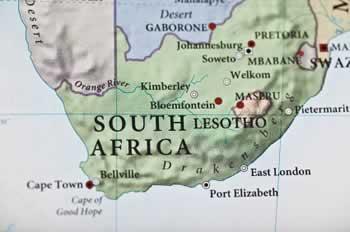
May 17, 2010 - Southern Africa focused Chromex Mining PLC (AIM: CHX) said it has made the strategic decision to move away from the contractor based model for the processing of its chrome ore and developing its own in-house skills. In line with this strategy as of 1 June 2010, the company will be taking full operational control of the Stellite opencast chrome mine processing plant, located on the Western Limb of the Bushveld Complex in South Africa.
In addition Chromex has appointed two key operations personnel, Jean du Plessis and Anson Gilbert, who will oversee operations at Stellite.
Du Plessis is a mining engineer with over 15 years experience in the chrome industry. He is currently general manager of mining at Hernic Ferrochrome, the fourth largest producer of ferrochrome in the world. He is currently responsible for all mining and chrome processing operations at Hernic and previous to this, was responsible for the development of eight chrome mines on the Bushveld complex. In his role at Chromex, he will be responsible for the Stellite mine and will be intimately involved in the development and operation of the Company's future projects.
Anson Gilbert is a metallurgist with in excess of 8 years experience in the chrome industry designing, commissioning and optimising gravity separation circuits. Gilbert will have overall responsibility for the metallurgical requirements of Chromex. He is currently overseeing the spiral modifications, and will be building and commissioning the Dense Media Separation (DMS) circuit at the Stellite mine.
Chromex CEO Russell Lamming said: "As we continue to expand our operations in both South Africa and Zimbabwe we are focussed on investing in our team and skill sets needed to convert our projects into profits. At this key stage in Chromex's development, it is imperative to optimise our current operations and to secure additional resources and I believe that the procurement of such experienced mining professionals reflects very positively on our company and the potential of our projects."
Astaire Securities featured Chromex in its Morning Report, saying the decision announced this morning marks a significant change of strategy. It is a move away from the flexible contractor model in favour of taking operations in-house.
"We believe this is a confident move, and necessary for what is a growing and more sophisticated company that will have an increasing demand for mining and processing expertise." It noted du Plessis' experience, saying this should be invaluable for all Chromex's projects, but especially underground Mecklenberg.
Similarly Gilbert's metallurgy expertise will help across the portfolio, and should help maximise the potential of a PGM/ Chromite operation, underground Stellite, the broker added.
Ocean Securities also commented on the news, saying that it is extremely encouraged by the calibre of these recent recruits to Chromex and believes they will be a key component of Chromex's aim to grow and convert existing projects into profits in the next 12 months.
"2009 was a difficult period for Chromex as the operation largely just washed its face. We expect news flow in the next six months to be extremely positive for Chromex, as the company begins to capitalise on the improving Chrome price, expand operations and begins promoting the company again," Ocean added.
Chromex is a dedicated chrome company established to acquire, control and develop chromite mining and processing facilities. It currently has two key mining assets located on the Bushveld Complex, which between them have total resources of approximately 41 million tonnes of chromite. The Mecklenburg mine lies in the east and the Stellite mine in the west. Both are owned and operated by South African registered Chromex Mining Co, which is 74 percent owned by Chromex and 26 percent owned by their Black Economic Empowerment (BEE) partner Umnotho WeSizwe.
The company's flasgship Stellite mine is currently ramping up production. It will initially produce approximately 20,000 run of mine (ROM) tonnes per month, increasing to 40,000 ROM tonnes per month once a dense media separation circuit (DMS) is installed at the plant. The DMS is expected to be completed during the third quarter of 2010. Stellite should reach full capacity by the first quarter of 2011 - producing approximately 500,000 run-of-mine tonnes in the year.
Additionally, in line with the company's strategy of building a broad portfolio of chrome and related mineral assets across southern Africa, Chromex has expanded its operations to Zimbabwe. As announced last week, in concluded the acquisition of Waylox Mining (Private) Ltd, a chrome mining company operating in Zimbabwe with a 683 hectare land position in the prospective Darwandale area and signed a binding heads of agreement acquiring 49 percent of Falvect Mining (Private) Ltd in Zimbabwe.
Waylox has been operating in Zimbabwe since August 2008 after acquiring the 683 hectares Trixie and Prince of Wales claims located in the prospective Darwendale area. The Darwendale area is located on the Great Dyke of Zimbabwe which is host to significant chrome resources.
The Trixie and Prince of Wales claims contain economic grades of alluvial chrome resources. The current mineral resource estimated on the 388 ha Trixie project stands at approximately 1.9 million tonnes at an average modelled grade of 13.8 percent chromium oxide Cr2O3. The estimate was calculated on the basis of the results of an exploration programme comprising 245 exploration pits across the five Trixie claims. The 216 ha Prince of Wales claims require further exploration which Chromex plan to conduct over the next six months.
Chromex has initiated a feasibility study on the Trixie claims which is expected to be completed in Q4 2010. Similar chrome operations on the Great Dyke are producing chrome concentrates with Cr2O3 grades ranging from 47 to 50 percent and Cr:Fe ratios in excess of 1.9:1.





